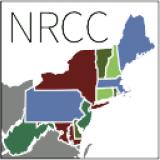Most Areas of the Northeast Have Recovered from the Drought.
Key Points
- Moderate drought (D1) persists along a sliver of the south shore of Long Island.
- Abnormally dry (D0) conditions are scattered throughout the rest of New York and New England.
- With snowfall running below normal for most of the region, precipitation events in the spring will be important for soil and aquifer recharge.
- Drought conditions have improved. In mid-December, almost 14% of the Northeast was abnormally dry with just over 3% still experiencing moderate (D1) to severe (D2) drought. At that time, Massachusetts had just over 3% extreme drought coverage. (See blue statistics bar below for current status by category.)
Current U.S. Drought Monitor map for the Northeast Drought Early Warning System with data valid for January 17, 2023. The U.S. Drought Monitor is updated each Thursday to show the location and intensity of drought across the country.
According to the latest U.S. Drought Monitor:
- Moderate drought (D1) conditions exist in 0.36% of the region.
- Abnormally dry (D0) conditions exist in 7.21% of the region.
U.S. Drought Monitor Categories
Abnormally Dry (D0)
Abnormally Dry (D0) indicates a region that is going into or coming out of drought. View typical impacts by state.
Moderate Drought (D1)
Moderate Drought (D1) is the first of four drought categories (D1–D4), according to the U.S. Drought Monitor. View typical impacts by state.
Severe Drought (D2)
Severe Drought (D2) is the second of four drought categories (D1–D4), according to the U.S. Drought Monitor. View typical impacts by state.
Extreme Drought (D3)
Extreme Drought (D3) is the third of four drought categories (D1–D4), according to the U.S. Drought Monitor. View typical impacts by state.
Exceptional Drought (D4)
Exceptional Drought (D4) is the most intense drought category, according to the U.S. Drought Monitor. View typical impacts by state.
Current U.S. Drought Monitor map for the Northeast Drought Early Warning System with data valid for January 17, 2023. The U.S. Drought Monitor is updated each Thursday to show the location and intensity of drought across the country.
According to the latest U.S. Drought Monitor:
- Moderate drought (D1) conditions exist in 0.36% of the region.
- Abnormally dry (D0) conditions exist in 7.21% of the region.
Current Conditions
U.S. Drought Monitor 4-Week Change Map
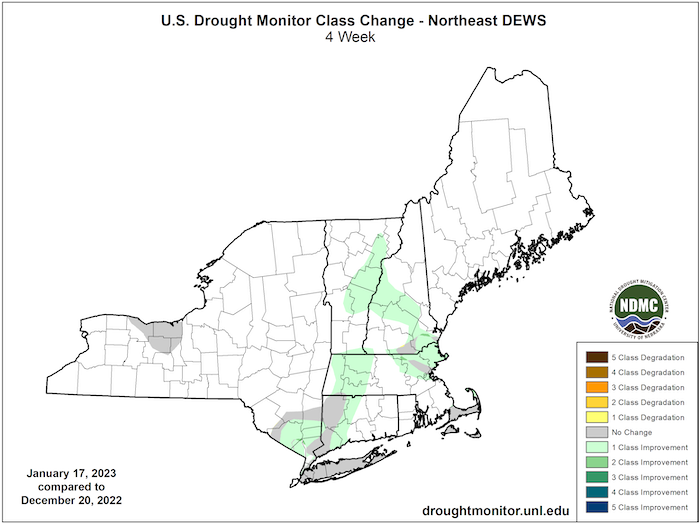
Accumulated Precipitation Departure from Normal
Continued dryness in eastern Massachusetts and precipitation deficits in the Spring could lay the groundwork for a rapid return to drought conditions in the summer.
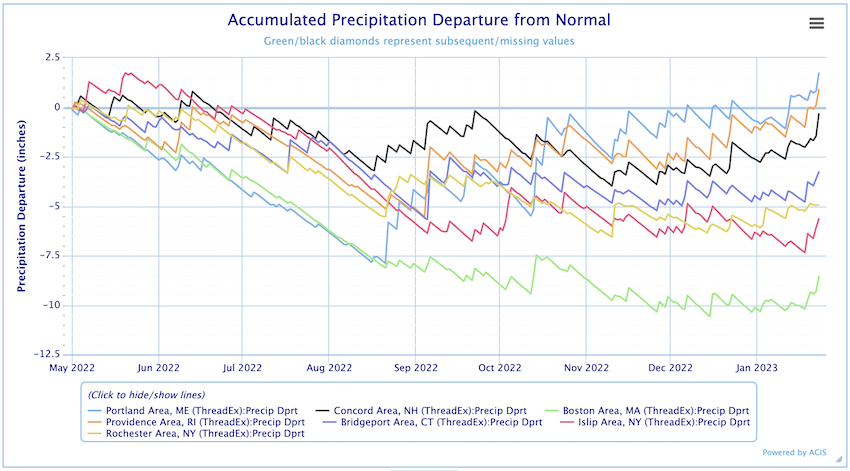
Northeast Snow Survey Update
The most recent snow survey map from mid-January shows snow water equivalent (SWE) of over an inch in portions of northern New England and northern New York, with little to no snow water equivalent for the rest of the Northeast. The next snow survey is January 30–February 1. Snow survey maps are available on the Northeast Regional Climate Center’s website.
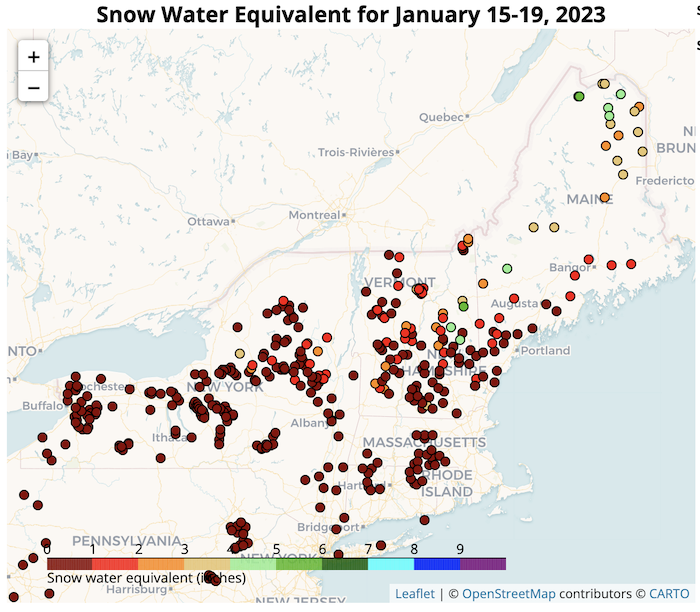
Snowfall has been below normal since December 1 for much of New York and New England, with deficits (as of January 23) of over 12 inches in areas such as Boston, MA, and Hartford, CT, and deficits of over 36 inches in Rochester and Syracuse, NY.
A storm early this week, from January 22–23, dropped 6-12 inches of snow on portions of central and eastern New York, northern Massachusetts, and northern New England, with 12–18 inches in parts of New Hampshire and Maine. This helped inch season-to-date snowfall totals closer to normal; however, deficits generally remain.
In addition, outside of those areas snowfall was limited. Central Park and Kennedy Airport, NY, had yet to see measurable snow as of January 23, six weeks later than usual. When measurable snow finally falls at these sites, it will be among their three latest on record, with the record latest currently being January 29. The snowy exceptions were the Buffalo and Watertown areas of New York, which saw significant lake-effect snowfall events in November and December. Another storm is expected to bring snowfall to the region on Wednesday, January 25.
State-Reported Conditions and Impacts
New England
- January 10, 2023: Washington Post – Below-Average Northeast Snow
- January 6, 2023: FOX Weather NYC –Snow So Far?
- January 7, 2023: FOX Weather NYC – Warmer Temperatures Verify Previous Outlooks; Snow Deficits for New England
Connecticut
- Connecticut Drought Information Center
- Drought Impacts:
- January 6, 2023: The Greenwich Time – 2022 One of the Worst Droughts in Recent Memory
- January 5, 2023: FOX61 – Drought Stage 1 Removed from Four Counties
- December 22, 2022: FOX61 – Top 2022 Weather Stories Included Drought
- December 14th, 2022: The Hour – Norwalk Lifts Water Emergency
Maine
Massachusetts
- Massachusetts Drought Management Task Force
- Drought Impacts:
- January 14, 2023: CapeCod.com – Drought Continues for the Cape/Islands
- December 29, 2022: The Sun Chronicle – Drought in the Top Ten
- December 27, 2022: The Eagle Tribune – North Andover Joins Water Resilience Task Force
- December 26, 2022: Telegram & Gazette – Natural Engineers Fight Climate Change
New Hampshire
- New Hampshire Department of Environmental Services: Drought
- Drought Impacts:
- January 3, 2023: CAI NH Public Radio – Climate Change, Drought, and Blueberries
New York
- New York State Department of Environmental Conservation (DEC): Drought
- Drought Impacts:
- January 21, 2023: Erie News Now – Drought Impacts Egg Prices
- January 16, 2023: CNYCentral – Snowmobile Clubs and CNY Tourism Suffer with Record Low Snowfall
- January 10, 2023: WGRZ – New York Snow Drought
- January 9, 2023: FOX Weather – No Snow? OK, Let’s Ski the Mall
- December 20, 2022: PCNR – Village of Cold Spring Lifts Water Restrictions
Rhode Island
- Rhode Island Water Resources Board: Drought Management Program
- Drought Impacts:
- December 21, 2022: Warwick Beacon – High Water Bills
Vermont
- State of Vermont Emergency Operations Plan (PDF)
- Drought Impacts:
- January 7, 2023: FOX Weather – Popular Northeast Ski Resorts Forced to Close Due to Unseasonable Warmth, Lack of Snow
Find additional impacts through the National Drought Mitigation Center’s Drought Impact Reporter.
Find local drought information by address, city or zip code on Drought.gov.
Outlooks
March–May Precipitation and Temperature Outlooks
The National Weather Service Climate Prediction Center's seasonal temperature outlook for March–May (issued January 19) continues to support the warmer than normal trend that was expected for the Northeast. Similarly, the seasonal precipitation outlook continues to suggest wetter than normal conditions only for western New York state.
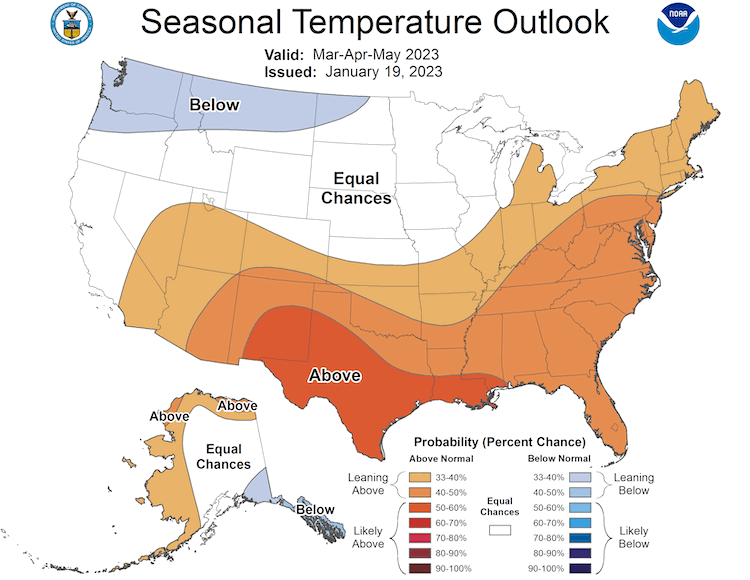
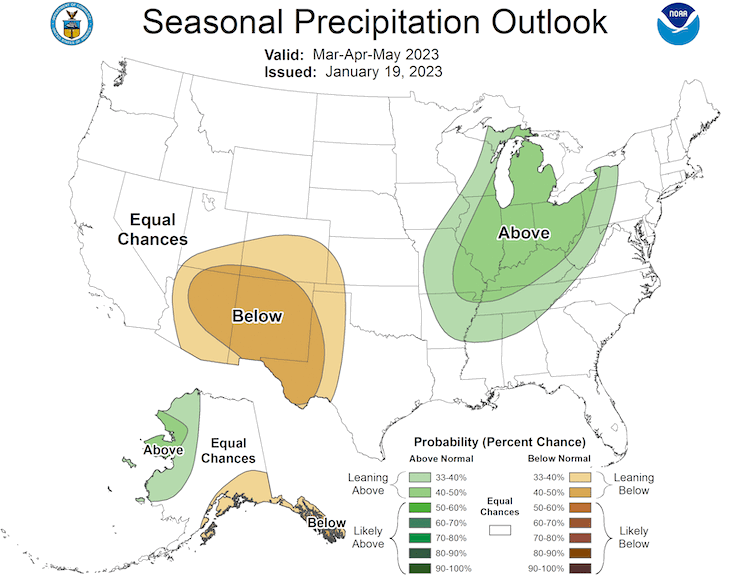
8–14 Day Temperature and Precipitation Outlooks
According to the Climate Prediction Center's 8–14 day outlooks (valid January 31–February 6), odds favor below-normal temperatures across the Northeast. There is a greater likelihood of above-normal precipitation in most of the region, with near-normal conditions favored in northern Maine.
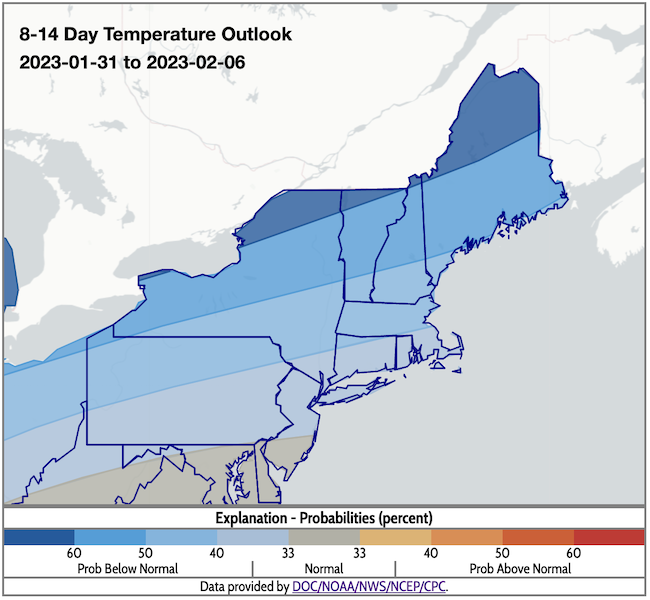
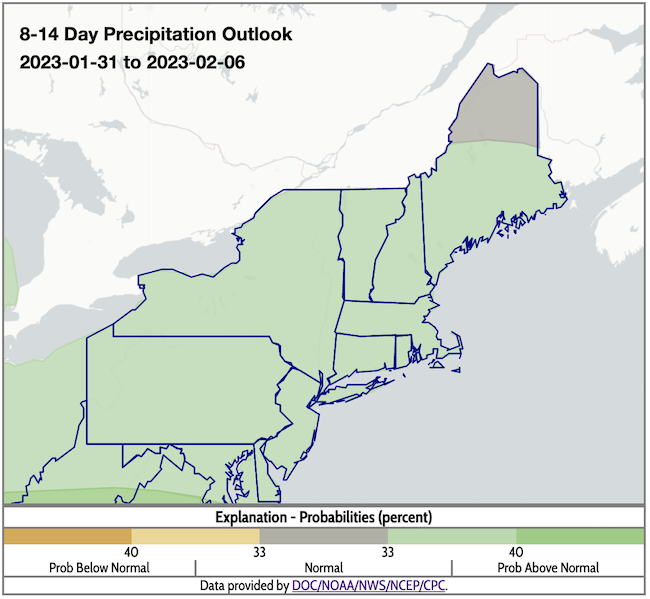
Seasonal Drought Outlook: January 19–April 30
The Climate Prediction Center's seasonal drought outlook notes, with moderate confidence, that a nearly drought-free status is possible in the coming months. February, March and April are climatologically favored for recharge of soil moisture, but there are concerns about the lack of snow so far this season—as noted in the Snow Survey update above. The lack of snow threatens groundwater recharge and any hedge against the onset of this primary drought indicator come summer.
View the Climate Prediction Center's full drought outlook discussion or Climate.gov's January 2023 U.S. Climate Outlook for more information.
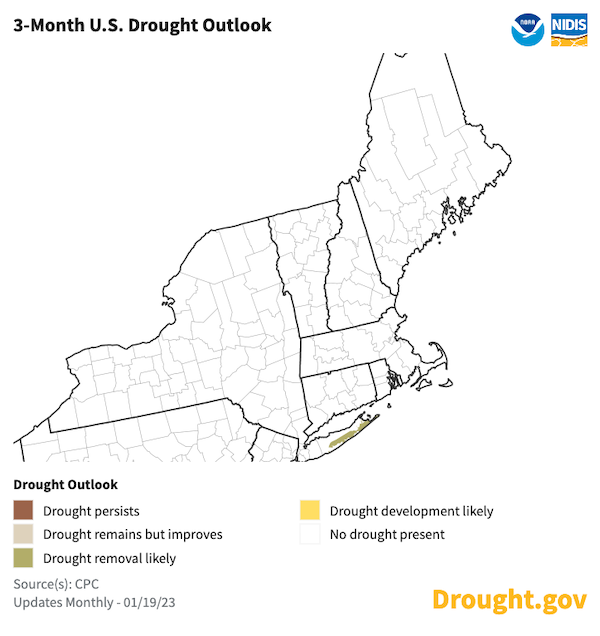
What We Are Watching
- View the Interstate Council on Water Policy's latest newsletter.
- Read this article from the International Journal of Wildland Fire: "Using Soil Moisture To Better Understand and Predict Wildfire Danger." More research is needed.
- This article, published in Water Resources Research, sheds light on the sequence of snow/melt/refreeze process and groundwater: "Drivers of Variation in Winter and Spring Groundwater Recharge: Impacts of Midwinter Melt Events and Subsequent Freezeback."
Resources
- A new drought communication and education tool is available from Trillium Studios Film: When In Drought, Massachusetts
- Look back at previous Northeast DEWS Drought Status Updates
- Your local National Weather Service office
- NOAA Regional Climate Services Monthly Webinar Series (next webinar is on January 31)
- USDA Northeast Climate Hub
- USGS New England and New York Water Science Centers
Contacts for More Information
Sylvia Reeves
Regional Drought Information Coordinator (Northeast DEWS)
NOAA/CIRES/National Integrated Drought Information System (NIDIS)
Email: sylvia.reeves@noaa.gov
Ellen L. Mecray
Regional Climate Services Director, Eastern Region
NOAA/NESDIS/National Centers for Environmental Information
Email: Ellen.L.Mecray@noaa.gov
Prepared By
Sylvia Reeves
NOAA/National Integrated Drought Information System (NIDIS), CIRES
Samantha Borisoff, Jessica Spaccio, Keith Eggleston, Art DeGaetano
Northeast Regional Climate Center
Ellen Mecray
Regional Climate Services Director, Eastern Region, NOAA
David Hollinger
USDA Climate Hubs
Gardner Bent
USGS New England Water Science Center
In partnership with National Weather Service Offices of the Northeast and State Climate Offices of the Northeast.
This drought status update is issued in partnership between the National Oceanic and Atmospheric Administration (NOAA), U.S. Geological Survey, and the U.S. Department of Agriculture (USDA) to communicate concern for drought expansion and intensification within the Northeast U.S. based on recent conditions and the forecasts and outlooks. NIDIS and its partners will issue future drought status updates as conditions evolve.



